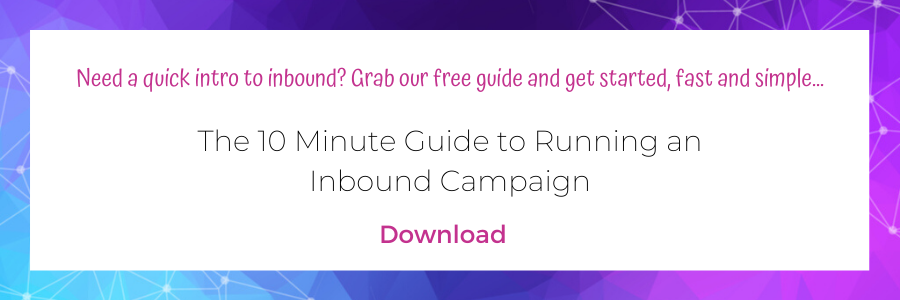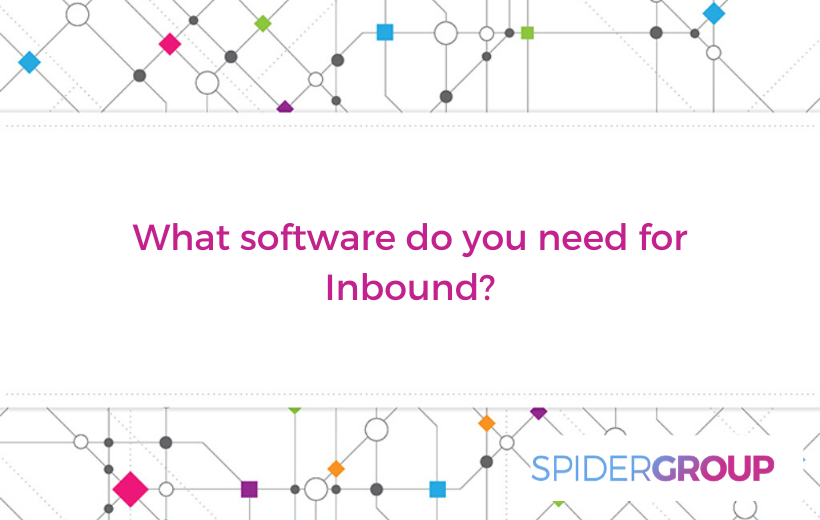As we're a HubSpot Partner , you might be expecting this to be an entire article about how you absolutely need HubSpot. Luckily, it's not a sales pitch - we'll look at lots of different tools you could use.
We can't deny that HubSpot is brilliant, and it will definitely come up, but we also know that there's no single way to do things, nor is there a one-size-fits-all approach to the best approach to marketing. But, there are definitely some tools you'll need if you want to explore inbound marketing for your business.
What is inbound?
First up, what is inbound marketing?
Inbound marketing is way of attracting new customers to your business, by creating high value content that's tailored to their needs and pain points. Instead of interruption (like outbound marketing), inbound is designed to be found by people who're already having a problem and need a solution.
By understanding the needs of your ideal customer, you can create content that's specific to them. This attracts them to your website, where you and your sales teams can engage with them. The aim isn't to 'sell', it's to provide real value so that working with you (or buying your product or service) makes perfect sense.
You attract more qualified, more relevant customers, allowing you to focus on delighting them.
The whole area of inbound relies on creating content that matters to your prospects - that's how they find you, how you engage with them, and how you demonstrate your value to them.
Content Tools
So, there's a whole lot of content creation that will be necessary for your inbound marketing efforts. To do this, you'll need to be able to publish that content. For blogging, most websites have an integrated blog, so that shouldn't be a problem. If you don't already have a blog, you should add one - either through a subdomain or on your main site.
But what about other content?
If you have high-value content that you intend to use as a lead magnet, you'll need somewhere to host it and capture your leads' information. Which means you'll be needing a landing page. Sure, you could host it on a regular page, but you run the risk of people getting distracted and wandering off without completing your form.
Creating landing pages is something that can be simple or challenging, depending on the tools you use and your comfort with them. If you create a standalone page on your website, you'll want to be able to create a specific landing page template to use, so that the page functions properly as a lead capture page.
Alternatively, you could use software that creates landing pages for you. HubSpot is obviously one of those tools, with tonnes of simple templates to choose from, but you could also use Unbounce or Lead Pages. The key thing is just to make sure you have landing pages with appropriate forms for your content and offers, so that you're making the most out of them.
One thing to note with landing pages - don't ask for more information than you need. If you have a high value piece of content, you can ask for more than if it's a less valuable item, but bear in mind that people will only part with their info if they perceive the value to be high enough. Don't go overboard with your forms.
You'll also want data collected from your landing pages to go directly to your CRM (more on that later), so make sure you have something that's fully integrated.
Social Media Tools
Once you've got some content out there, you'll need to be promoting it. And one of the main ways people do that is through social media (though you should be using social to engage, too, not just as a broadcast tool).
If you're using multiple social platforms - Twitter, Facebook, LinkedIn, Instagram, etc - you could easily take up a whole lot of time logging into each of them and posting messages throughout the day. But that's time consuming and inefficient - and chances are you don't have the bandwidth to do it all.
Instead, get a tool that lets you not only log into everything all at once, but also enables you to pre-schedule your content promotion posts, and keep an eye on social listening so you can react as necessary to topics or mentions that are relevant to you and your audience.
There are a range of tools that can help you do this - from Sprout Social and HubSpot to Buffer and Hootsuite. The latter two have free options that can help you get started, albeit with some limitations on the number of platforms you can attach to them and the number of posts you can schedule.
The main thing is to plan a block of time each week to schedule your posts, so you don't have to keep going back to it every day. Then, you can spend your social media time on reacting, responding, and engaging, rather than trying to do everything all at once.
Email Marketing Tools
Email marketing is a huge part of inbound marketing. As well as your existing customers, you're also developing quite the marketing list with your content and landing pages. So you'll need a tool to help you communicate with all of them.
You'll want to be able to segment your lists - segmentation leads to much better conversion rates - and send different messages to different audiences, whether they're existing clients or hot prospects. You also need a tool that lets you pre-schedule and easily design your emails so that you can control every element to best effect.
MailChimp is one of the most famous tools out there, but there's also ConstantContact, ActiveCampaign, and GetResponse, among others. Prices vary, and you should keep an eye on whether or not your emails will have the provider's branding added to them (free accounts often have this).
We do have to mention HubSpot specifically here. The email marketing element of the platform is actually available on a free account, which is an amazing bonus. If you don't already have a tool, we'd recommend getting a free account and giving it a go. The email customisations are top notch, the drag and drop editor is super simple, and the segmentation and personalisation opportunities are pretty much endless.
CRM Tools
If you're going to be gathering information about your prospects, and using that information to engage with them to provide value, you need somewhere to store that info in order to use it effectively.
Many businesses, especially smaller ones or those without a sophisticated contact strategy, use spreadsheets to contain customer data. There are a few issues with this.
- Who owns the data and keeps it up to date?
- How secure is the data? GDPR isn't just about not sending spam emails, it's also concerned with security of the data you hold.
- Who has access?
- Is all the data in the same place or are there disparate spreadsheets dotted around?
- How do you know if a particular customer has been contacted recently?
Having CRM software solves these issues. Keeping a central database ensures that you have all of your information in one place, accessible to the people who need it, saved securely. The best CRMs allow you to see the entire history of a contact - from when details were last updated to when the customer was last contacted. Everyone can see the same information - so your sales team will know if a customer has received a recent marketing email, for example.
There are tonnes of CRMs out there, with huge variances in complexity and features. From Microsoft Dynamics CRM, which is incredibly powerful but sometimes confusing, to the famous Salesforce, the key is to find one that works for you.
You won't be surprised to know that we use HubSpot CRM. What's particularly great about it is that the CRM is free. Seriously. And it's not a free trial, or a throttled version of the software, it's actually, genuinely free. And it comes with the Ads and Email Marketing software, as well as chatbots and live chat. So if you don't already have a CRM, it's definitely one we'd recommend.
Analytics Tools
No matter what form of marketing you're doing, you need to be able to track its performance. How will you know what's working if you can't see your analytics? You won't.
In order to continually optimise and improve your efforts, you need to be able to see exactly how each element of your strategy is performing.
At an absolute minimum, you need Google Analytics and Search Console on your website. Between the two of them, you can see how your site is performing and how people are finding you.
This area, however, is the one where enterprise-level software like HubSpot really comes into its own. Rather than having to track analytics on every individual piece of software you're using, you have one central place where all of your details are stored - so you can actually see what's contributing to your bottom line. Rather than go into all the details again, check out our post on measuring marketing ROI using HubSpot.
No matter what platform(s) you use, you'll want to be able to test and measure your activities, spend more time and effort on those with the highest return, and continually make tweaks and adjustments to ensure you're getting the best results possible from your activities.



